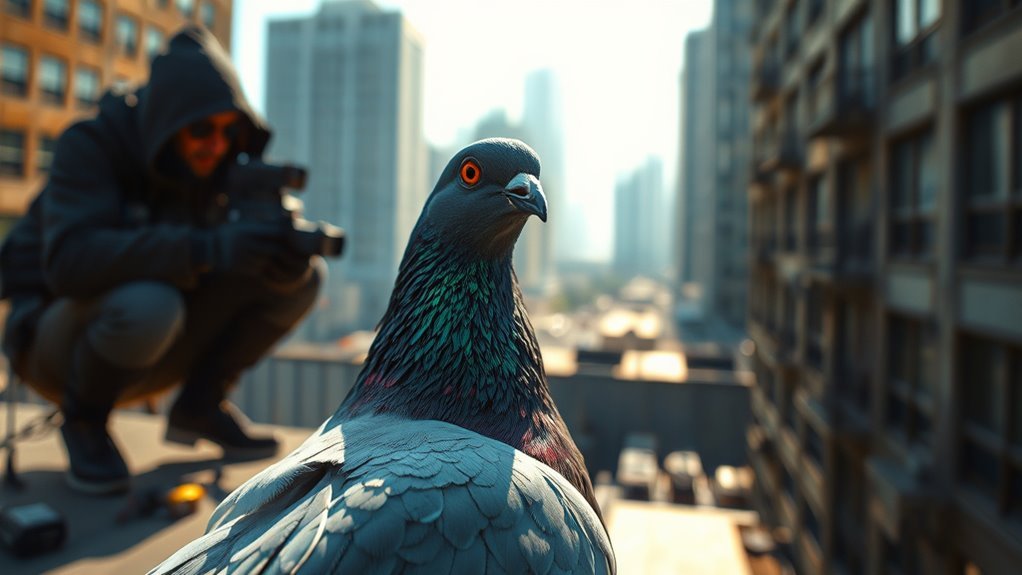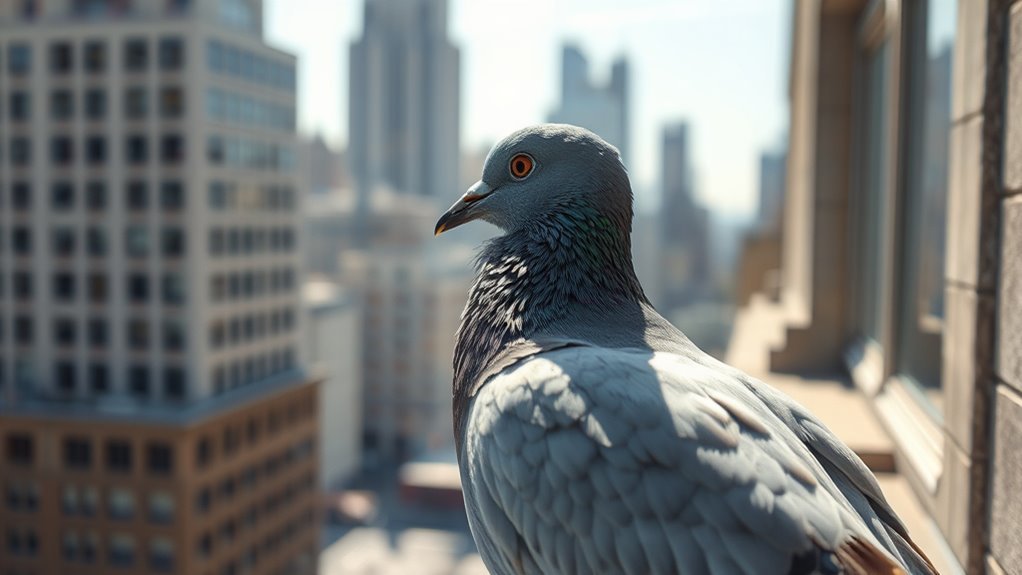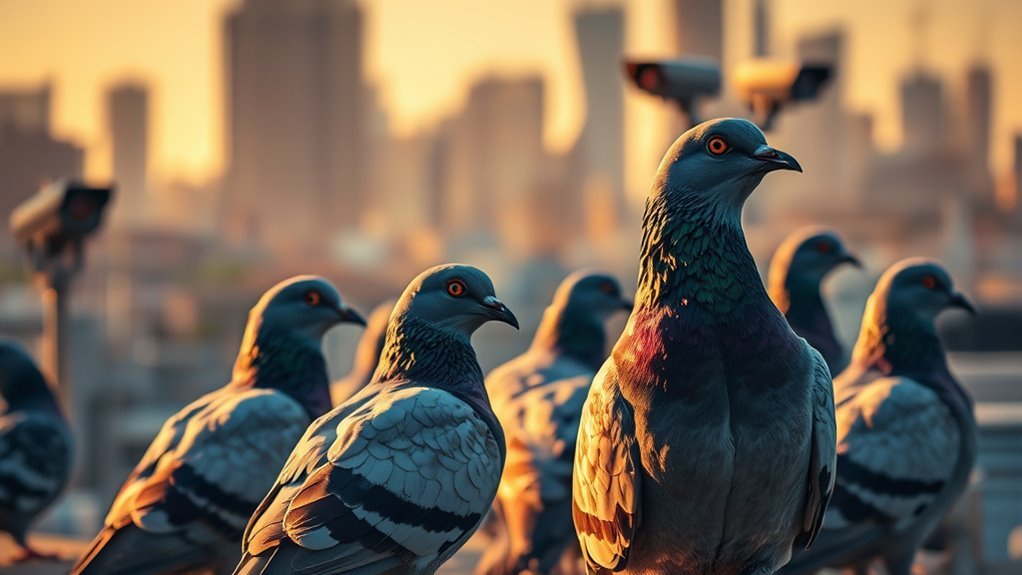To investigate whether pigeons are government drones, start by observing their behavior for unusual flight patterns and interactions. Look closely at their physical features, noting anything that seems out of the ordinary. Analyze group dynamics, searching for synchronized actions or formations that defy typical pigeon behavior. Engage your community to share experiences and document findings collectively. Use technology to enhance your observations. By pursuing these angles, you may uncover intriguing insights regarding the truth behind these seemingly ordinary birds.
Understanding the Origins of the Pigeon Drone Theory

Although it might sound far-fetched, the theory that pigeons are government drones has intrigued many and sparked numerous debates. To understand how this idea emerged, you’ve gotta consider the historical context. Since the Cold War, conspiracy theories have flourished, often fueled by distrust in authority. The rise of surveillance technology made people question what’s real and what’s fabricated. As rumors spread, the notion that pigeons could be sophisticated surveillance tools took flight. This theory taps into deeper fears about privacy and governmental overreach, appealing to those who crave freedom. Are these winged creatures truly harmless, or do they serve a hidden agenda? By examining the origins of this theory, you can uncover a compelling narrative about our society’s growing skepticism.
Observing Pigeon Behavior for Anomalies

Have you ever noticed a pigeon flying in a way that just doesn’t seem right? Changes in their social interactions or feeding habits could hint at something more than mere avian behavior. By observing these anomalies, you might uncover clues that challenge everything you thought you knew about our feathered friends.
Unusual Flight Patterns
As you observe the seemingly mundane flight patterns of pigeons, you might start to notice peculiarities that raise questions about their behavior. Why do some pigeons suddenly soar to altered altitudes, only to drop back down without apparent cause? These erratic movements could suggest more than just typical avian antics. Could they be responding to unseen signals or directives? Pay attention to how they change direction unpredictably, darting in ways that defy natural instinct. It’s essential to ask: are these birds genuinely free, or are they part of something more complex? By scrutinizing these unusual flight patterns, you might uncover a hidden narrative that speaks to larger issues of surveillance and autonomy. Your observations could reveal the truth behind these feathered enigma.
Social Interaction Changes
Shifts in social interactions among pigeons can be just as telling as their flight patterns. When observing these birds, pay close attention to their social dynamics and communication signals. Are they clustering more tightly than usual? Are they engaging in unusual vocalizations? Such changes could signal something beyond natural behavior.
| Behavior Type | Observational Notes |
|---|---|
| Clustering | Unusual tight-knit groups |
| Communication Signals | Increased cooing or silence |
| Aggression Levels | Heightened territorial disputes |
Feeding Behavior Observations
While observing pigeons, their feeding behavior can reveal intriguing anomalies that warrant closer examination. You might notice distinct patterns, like some pigeons hesitating to feed or only consuming specific types of food. Are these behaviors mere quirks, or could they hint at something more sinister? Analyzing feeding habits can uncover discrepancies that challenge our perception of these birds. Pay attention to how they interact with their environment—do they seem overly cautious or synchronized in their movements? These behavioral patterns could suggest a level of programming or control, raising questions about their true nature. By scrutinizing these feeding behaviors, you’re not just witnessing pigeon life; you could be uncovering a hidden narrative about freedom and surveillance.
Analyzing Physical Features of Pigeons

Pigeons, often seen cooing on city streets, possess a unique set of physical features that make them intriguing subjects for analysis. Consider their feather texture: is it smoother in some areas, possibly indicating advanced design? This variance might suggest a purpose beyond mere aesthetics. Then, there’s the eye coloration—some pigeons sport striking hues that could hint at sophisticated imaging capabilities. Are these features merely evolutionary adaptations, or do they point to something more? By closely observing these traits, you might uncover unsettling truths about their nature. It’s essential to question the ordinary and seek freedom from the narrative that pigeon behavior is just that—ordinary. Dig deeper, and you may find evidence of a compelling alternative reality.
Identifying Unusual Patterns in Pigeon Groups
Have you ever noticed how some pigeon groups fly in unusually tight formations or behave oddly during feeding? These flight patterns and feeding behaviors might not just be random quirks; they could hint at something more significant. By observing these anomalies, you could uncover clues about whether these birds are truly just pigeons or something else entirely.
Flight Formation Anomalies
How can we explain the unusual flight formations sometimes observed in pigeon groups? These anomalies might seem like mere quirks of nature, but they could hint at something more sinister. Consider the flight mechanics involved—pigeons typically fly in organized patterns, yet some formations defy logic. Are they coordinating their movements, or could it be a result of aerial surveillance? If you observe sudden shifts or erratic patterns, it’s worth questioning whether these birds are functioning independently or following programmed directives. It’s essential to remain vigilant and analyze these formations critically. By doing so, you might uncover hidden truths about their purpose, challenging the narrative that these seemingly innocent creatures are just part of our urban landscape.
Behavior During Feeding
Observing pigeons during feeding can reveal intriguing and sometimes perplexing behaviors that warrant closer examination. You might notice unusual feeding patterns that raise questions about their true nature. Have you ever seen synchronized pecking in a group? It’s fascinating, almost choreographed. Consider these points:
- Groups forming tight circles, seemingly coordinating their movements.
- Sudden shifts in pecking rhythm, as if responding to an unseen signal.
- Pigeons pausing abruptly, then resuming as if on cue.
These behaviors could suggest something more than mere instinct. Are these pigeons simply feasting, or is there a deeper, perhaps more calculated reason behind their actions? By analyzing these feeding habits, you might uncover clues about their true identity. Keep a keen eye; freedom of thought depends on scrutiny.
Investigating Pigeon Interactions With Humans
While it might seem like a stretch to contemplate pigeons as anything other than common city dwellers, their interactions with humans reveal a complex relationship that deserves closer scrutiny. Have you ever noticed how pigeons communicate among themselves, cooing and strutting as if they’re monitoring your every move? This peculiar behavior can provoke varied human reactions, from indifference to irritation, and even curiosity. Are they merely scavengers, or is there something more intricate at play? Observing these interactions can uncover insights into their potential roles as government drones. By analyzing how they adapt to urban environments and respond to human presence, we might gain a clearer understanding of their true purpose. Isn’t it worth investigating?
Utilizing Technology for Enhanced Observation
The intricate relationship between pigeons and humans invites a look at how technology can enhance our understanding of these birds. To investigate whether they’re merely creatures of the sky or sophisticated surveillance tools, consider leveraging modern technology for data collection.
- Utilize drones to mimic pigeons, observing their behavior without interference.
- Deploy motion sensors in parks to track their flight patterns and interactions.
- Use camera systems to analyze their habits and gather footage for further examination.
These methods can help reveal the truth about pigeons while respecting your desire for freedom. By embracing technology, you can gather compelling evidence and challenge any suspicions regarding their role in surveillance. After all, knowledge is power, and it’s your right to seek the truth. Additionally, integrating real-time data analytics can significantly enhance your observations and findings in this investigation.
Gathering and Sharing Evidence in Your Community
To uncover the truth about pigeons in your community, it is essential to gather and share evidence collaboratively. Start by observing their behavior—do they act unusually or seem unafraid of humans? Document your findings with photos and notes. Engage neighbors in discussions about their own experiences; fostering community awareness is key. Set up group meetings to analyze the evidence together, ensuring a collective understanding of the situation. Utilize social media platforms to share your discoveries and connect with like-minded individuals. The more you share, the stronger your case against the idea of these birds being mere pigeons. Remember, transparency and collaboration empower you to challenge the status quo and reclaim your freedom from surveillance. Together, you can reveal the truth.
Frequently Asked Questions
Are There Any Credible Sources Supporting the Pigeon Drone Theory?
You might want to explore the intriguing intersection of pigeon surveillance and drone technology. While some claim it’s a whimsical theory, credible sources are scarce, leaving you to ponder the truth behind these feathered observers.
How Can I Distinguish Real Pigeons From Potential Drone Replicas?
To distinguish real pigeons from potential drone replicas, observe their anatomy closely. Notice organic features versus mechanical elements. Consider drone technology’s sound and movement—real pigeons exhibit erratic flight patterns, while drones tend to be more stable.
What Are Common Misconceptions About Pigeon Drones?
Aren’t people often misled by pigeon behavior, thinking it’s all just natural? With advanced drone technology, it’s easy to confuse the two. Understanding these misconceptions helps you see through the veil of surveillance.
Is There a History of Similar Conspiracy Theories?
Isn’t it fascinating how historic conspiracies often involve similar claims? You might find it intriguing that people have long suspected surveillance through everyday creatures, raising questions about freedom and our perception of reality in society.
How Do I Report My Findings to Authorities?
To report your findings, gather all evidence meticulously. Follow local reporting procedures, ensuring you present your data clearly. Are you prepared to challenge the status quo and advocate for transparency? Your voice matters in seeking freedom.

